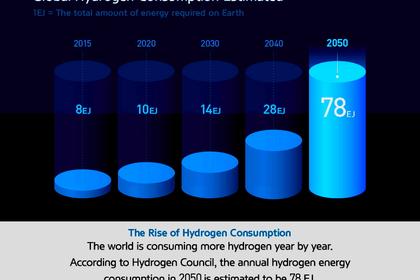
GREEN HYDROGEN IS COUNTERPRODUCTIVE

By Roger Arnold Director Silverthorn Institute
Preface
In making the case for a particular approach to the problem of CO2 emissions, two different aspects need to be addressed. One is technical merit: is the approach feasible from an engineering perspective, is it scalable to the degree needed to make a difference, is it environmentally benign, etc. I’ll have a few things to say about that side of the approach I’m covering here. However, technical merit is only part of the story.
Equally important is the strategic aspect. Who will support it, who will oppose it, what resources can they bring to bear? Can the approach be expected to navigate the political, economic, and social waters it must traverse on its way to implementation? And if implemented, how will it fit in with other programs to improve social, economic, and environmental conditions? Can it successfully contribute to the goal of slashing atmospheric CO2 emissions? Those can be hard questions to answer, but they’re vitally important.
Before I dive into the substance of the case I want to make, I should establish some context. I’ll be talking about “the hydrogen economy”. It’s a notion that’s been around for some time, and has acquired different meanings for different individuals. For many, it’s closely associated with the FreedomCAR partnership launched early in the administration of George W. Bush. The hype around efforts to develop a practical hydrogen fuel cell vehicle and the failure to deliver severely tarnished the hydrogen vision.
The particular vision for a hydrogen economy that I’m covering here is different. It’s not tied to hydrogen as a transportation fuel, nor does it depend on electrolytic production of hydrogen from surplus power. It doesn’t preclude those uses; indeed, the infrastructure it creates would facilitate them. But it doesn’t depend on them. It simply focuses on hydrogen as a zero-carbon alternative to natural gas for dispatchable power generation.
Dispatchable power generation from hydrogen can be efficient and fast responding. Importantly, it can also have low capital cost per megawatt of capacity. That makes it well suited for use in secondary power generation. It can serve equally well as a complement to baseload supply from nuclear power or to variable supply from wind and solar. It doesn’t foreclose options.
For the hydrogen economy in this vision, the way the hydrogen is produced is irrelevant -- so long as it’s technically and economically viable and free of CO2 emissions to the atmosphere. But within the hydrogen advocacy community, one faction cares very much about how hydrogen is produced. They insist that it be “green” hydrogen, produced by electrolysis of water using renewable energy. They specifically oppose production of hydrogen from fossil fuels, even if all of the CO2 associated with such production is captured and sequestered. Hydrogen produced in that manner is called “blue” hydrogen. I’ll refer to opposition to blue hydrogen as the “strictly green” position of hydrogen advocacy. It’s a position that opposes CCS on principle.
I regard the strictly green position as irrational and counterproductive. It is an impediment to efforts to quickly slash carbon emissions and limit the effects of global warming. Some of the reasons for that involve technical issues, and I’ll get to those. More important, in my opinion, are its strategic flaws. I’d like to start by examining those.
Strategic considerations get little attention in the theater of public debate. I won’t delve into why that might be so, but it’s something I think ought to change. Strategic considerations are at the heart of the approach to the hydrogen economy that I’m advocating. They make it not just a good way forward in the fight to rein in global carbon emissions, but arguably the only way that has a realistic chance of success. It boils down to human nature. Human nature and the art of war.
War Strategy
The Art of War is an ancient military treatise. It was written in the 5th century BC by legendary Chinese general and imperial advisor Sun Tzu. Still studied today in military academies, the work is notable for its pragmatic orientation. Sun Tzu is the antithesis of the tribal warrior hot to slay enemies. He emphasizes the need for clarity and understanding: clarity in one’s goals and understanding of the motives, strengths, and weaknesses of both one’s opponents and one’s own forces.
Sound strategy starts from that understanding, and aims to achieve its goals at minimum cost. While minimum cost to one’s own side is primary, Sun Tzu implicitly holds that minimizing cost to the enemy is also important when possible. Maybe that’s because the enemy in his era were expected to become future subjects of the Emperor, or de-facto allies against other enemies. If they could be made to accede to the Emperor’s requirements without costly military battle, that was best for all. In any case, making defeat as painless as possible to one’s opponents is a good way to soften resistance and achieve one’s own goals at less cost.
So what does this talk of war strategy have to do with energy policy and climate change? Quite a lot, in my opinion. You see, whether we think of it that way or not, we’re engaged in a war. And the war strategy of those of us fighting to curtail global carbon emissions frankly sucks! We’ve muddled our goals, demonized our opponents, and fallen prey to major follies that Sun Tzu warns about.
Lost Decades
A policy that would be effective for curtailing carbon emissions has been known and advocated by economists, both liberal and conservative, from the day that rampant carbon emissions were recognized as a problem. That’s to put a price on carbon emissions that properly reflects the external costs of dumping CO2 into the atmosphere. A price enables cleaner energy resources to compete on a level playing field. It has yet to happen -- not on a scale that would make a difference. Europe has an emissions trading scheme, but for various reasons, it’s been largely ineffective. British Columbia has a carbon tax, and it has worked out well for that progressive Canadian province. But BC represents a very tiny piece of the world economy.
The decades-long failure to enact policies that would be effective in driving a transition in our energy economy is no accident. If the world were to abandon the use of fossil fuels any time soon, there are many trillions of dollars of reserves that would become stranded assets. Those assets are held almost entirely by oil exporting nations and large corporations. For exporting nations, they’re a key source of national wealth. For corporations, mineral rights and long term licenses represent much of their market worth. It’s silly to expect these powerful players to roll over and allow so much potential wealth and future income to be placed off limits. Of course they oppose it! They’ve done and will continue to do everything they can to block it.
Given the financial resources these players command, doing “everything they can” is quite a lot. Most corporations have competent PR departments; beyond that, they can hire lobbyists, fund friendly think tanks, and hire professionals skilled in the arts of media relations and “perception management”. All for a very tiny slice of the many trillions of dollars collectively at risk.
There’s a great deal that could be written about how fossil fuel interests have been fighting to defend their financial futures. I won’t be getting into that, but Naomi Orestes and Erik Conway did a good job of it in their 2010 book, Merchants of Doubt. In 2014, an updated documentary film by the same title was released. I recommend both for anyone interested in understanding the politics of the climate change debate.
It’s important to understand that the campaign waged by the fossil fuel interests has never been a monolithic campaign aimed at achieving a specific “victory” at some point in the future. Strictly speaking, it’s not even correct to refer to it as a campaign, singular. It’s been a kind of guerilla warfare: a series of seeded memes and PR efforts aimed at spreading confusion and disruption among the attacking forces. It was never a goal, for example, to actually overturn the scientific consensus about anthropogenic CO2 emissions as responsible for global warming. Being counterfactual, that would have been difficult. Moreover, it wasn’t necessary. It was only necessary to sow enough doubt and confusion to forestall a consensus for action. To a large extent, the promoted memes and PR efforts only needed to provide political cover for inaction by legislators already beholden to fossil fuel interests.
With what’s at stake, the resistance by fossil fuel interests to policies that would be effective in driving a transition away from fossil fuels is unsurprising. However, the resistance would likely not be as vigorous nor as effective were it not for the “no quarter” mindset of those of us leading the attack. “Keep it in the ground” is a mantra that makes the stranding of fossil fuel assets the explicit and primary goal of climate action. It advertises a “no quarter, no compromise” intent to lock away and effectively destroy wealth worth trillions of dollars to those holding it.
Strategy aside, that’s probably not a brilliant tactical approach.
Clarifying the objective
At the most basic level, the problem we need to address is rising levels of greenhouse gases (GHGs) in the atmosphere. CO2 released from burning of fossil fuels is the dominant GHG; there’s no question that quickly ending all use of fossil fuels would solve the problem. Hence “keep it in the ground” is a solution. But is it the only solution? The climate change problem is, after all, not fossil fuels per se. It’s the CO2 released into the atmosphere when we burn them. If we can tap the chemical potential energy stored in fossil fuels without releasing CO2 into the atmosphere, why should that not be an option? Why not embrace CCS?
The technical, economic, and political issues around CCS are not simple. Large scale CCS and the carbon emission taxes necessary to fund it at scale play out differently for each of the three major segments of fossil fuel interests—coal, oil, and natural gas. It would take a dissertation to do justice to the topic. I’ve no interest in writing one. I will say, however, that I think the issues that get the most attention in debates are not the ones that really matter.
Long term safety / security of CO2 storage is one of those. It gets a lot of attention, yet as a serious issue, it’s largely bogus. Sites for geological storage need to be evaluated with care, but the issues have been well studied. The scientific consensus is that there is no shortage of good sites in which CO2 could be safely sequestered indefinitely. Safety, however, is a marketable issue. Questioning safety is a time-honored tactic for opposing any policy one doesn’t like, when one’s real basis for opposition is hard to articulate or difficult to sell.
Another objection often raised to CCS is telling. It’s that CCS is a ploy advanced by fossil fuel interests—or by those they have duped—to enable continued use of fossil fuels. The claim may or may not be true, but if it is, what of it? Our primary goal is to slash CO2 emissions to the atmosphere. If CCS can enable that to be accomplished while continuing to tap fossil energy, why oppose it?
On the other hand, if one has made the financial ruin of fossil fuel interests the primary goal, opposing CCS is understandable. But it means pursuing a difficult attack against forces that have proven very adept at defending themselves.
The strategic case
Strategically, if the goal is really to reduce CO2 emissions to the atmosphere, it would make sense for climate activists to embrace CCS. Although fossil fuel interests are not a monolithic block, most of the oil and gas majors would likely drop covert opposition to carbon emissions pricing if they knew that CCS was an assured option. Given CCS, a price on carbon emissions is not especially harmful to them. It could even be advantageous. A key reason is CO2-based enhanced oil recovery. It turns out that CO2-based EOR should be more help than hindrance in a clean energy transition.
Oil companies understand that a price on carbon emissions will accelerate the trend for electrification of transport and heating. But they also understand that that trend is now under way and is effectively unstoppable. It’s just a matter of how quickly it proceeds. A price on carbon emissions will accelerate the shrinkage of the market for coal, oil and distributed natural gas; on the other hand, production of blue hydrogen will extend the market for raw natural gas as feedstock. It’s possible that CCS could extend the market for oil as well, in a manner that doesn’t emit CO2 to the atmosphere.
CO2 emissions from the transport sector are at present roughly equal to those of the power sector. As the transportation sector is electrified, the market for oil will shrink. At the same time, the power market will grow. Most of that growth will come from zero-emissions generation of one sort or another. Options include nuclear and all forms of renewables, plus blue or green hydrogen. There is one intriguing new possibility as well: flexible thermal generation from newly built Allam cycle power plants.
The Allam cycle is a supercritical CO2 Brayton cycle. It is flexible, highly efficient, and very compact. Thermal input is from oxy-fueled combustion of oil or natural gas, with complete capture and sequestration of exhaust. The exhaust is essentially pure CO2. CCS thus provides the potential for oil to transition from a highly carbon-emitting fuel for transportation to a fuel for zero-emissions power generation.
While the benefits of CCS to embattled fossil fuel interests are obvious, climate activists are entitled to ask what’s in it for their cause? Especially given that the first, easiest, and most economical way to sequester CO2 at scale is to use it for enhanced oil recovery. The popular belief is that the oil recovered through CO2-based EOR will release more CO2 when it is burned than what was used to recover it.
That belief happens to be correct -- at least in the case where oil field operators must go out and purchase the CO2 they use. That gives them a strong incentive to maximize the ratio of recovered oil to injected CO2. Critics, however, assume that the recovered oil will increase the worldwide total of oil burned. That is not correct. Oil production is now strongly demand-limited. There is very little demand elasticity. That means that higher production from one source will translate to lower production from others. Thus EOR, rather than increasing total extraction, merely enables producers using it to serve a larger fraction of remaining demand. The larger fraction comes at the expense of E&D (exploration and development) for new wells that will not be needed.
EOR-enabled curtailment of E&D activities is a big win for the oil majors. They become better able to meet remaining demand from mature reserves without the expense of E&D. It allows funds that would have been put into E&D to instead be put into diversification. They can better prepare for “life after oil”.
Curtailment of E&D is also a win for the environment. The environment is spared all the road building, land clearing, and pipeline laying for new wells. Not to mention the sand mining for fracking operations. It’s a win for the climate in terms of CO2 sequestered and not released into the atmosphere, and also for what it does to hasten the transition of oil and gas companies away from fossil fuels. The companies can reduce their inventory of reserves that would become stranded, while not digging themselves in deeper by opening new reserves.
In contrast to those results, should the strictly green camp remain adamant in its opposition to blue hydrogen and CCS, there is no upside for any of the fossil fuel interests in fair pricing of CO2 emissions. Their only recourse is to continue the war and impede the transition away from fossil fuels as much as they can. The covert campaigns questioning the seriousness of climate change and opposing carbon pricing will continue. Given recent history, it seems likely that they’ll succeed.
The Dissenting position
The “strictly green” position on hydrogen discounts these strategic arguments for CCS. It holds that there’s no need to compromise with fossil fuel interests. Never mind some ancient Chinese general and his advice about leaving one’s opponents a “viable avenue of retreat”. The bastards deserve to be crushed!
Proponents of the strictly green position see no need for “blue” hydrogen. Green hydrogen may currently be several times more expensive, but the plunging cost of wind and solar energy—and of electrolysis equipment once it’s produced in sufficient volume—will inevitably make green cheaper.
In that view, all we need do is to keep the current policy incentives for renewables in place and continue deploying new wind and solar capacity. Admittedly, natural gas will still supply most of the backing generation needed when production from variable renewables is below demand. However natural gas is clean compared to coal, and the need for it will eventually dwindle. As the buildup of wind and solar capacity progresses, natural gas for backing generation will be supplanted by green hydrogen. Green hydrogen will be produced at times when excess VRE generation is available at very little cost. The produced hydrogen will be so cheap that it will automatically replace natural gas for dispatchable generation.
Relying on that strategy strikes me as risky. For one thing, I believe it underestimates the ability of the mercenary PR soldiers of the fossil fuel interests to raise doubts about the significance of climate change and the urgency of transitioning away from fossil fuels. At the same time, it overestimates the ability of climate activists to influence policies to the degree that would be needed for their vision of a green hydrogen future to be realized.
The strictly green vision for a hydrogen future requires certain conditions. Overbuilding of wind and solar resources is required to generate the surplus power needed to make large scale electrolysis of water economical. Hefty ongoing subsidies are required to support the natural diseconomies of overbuilding. But ongoing subsidies are vulnerable. Laying the groundwork for challenging them may already be under way. Stories of the adverse health effects of infrasonic noise from wind turbines are in the news. The impact of grid-scale solar farms on desert ecosystems and wildlife habitat is cited with what seems to be increasing frequency. California’s recent power blackouts and the high cost of electricity in the nation’s greenest energy state haven't helped. They undermine the case for rapid expansion of renewables.
The “strictly green” advocates for hydrogen of course have counterarguments for these points. Both sides in the debate have plenty of ammunition they can fire at one another. But if I had to bet on the outcome of this particular fight, I’d say that fossil fuel interests are more likely to prevail. Since I don’t feel it’s a necessary fight to begin with, I recommend it be avoided.
Technical considerations
What I’ve written above only scratches the surface of the arguments for and against CCS in a hydrogen economy. I haven’t touched on the complex three-way game involving fossil fuels, renewables, and nuclear. Fossil fuel interests can play off nuclear against renewables to create a stalemate that serves their own interests. But I feel I’ve gone as far as I reasonably can (or should), painting with broad strokes on the strategic canvas. To go further, we need to get specific about some of the technical issues that bear on the strategic case.
Since this post is already pretty long, I’ll take up the technical issues in a separate post next week. Meanwhile, I welcome any and all comments on this one.
-----
This thought leadership article was originally shared with Energy Central's Clean Power Community Group. The communities are a place where professionals in the power industry can share, learn and connect in a collaborative environment. Join the Clean Power Community today and learn from others who work in the industry.
-----
Earlier:


















